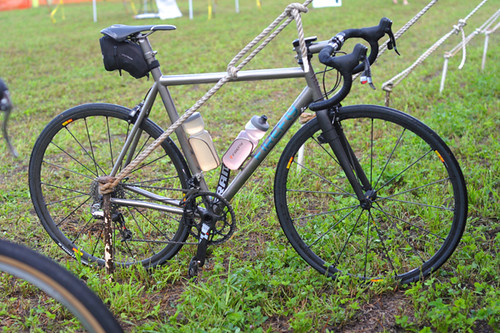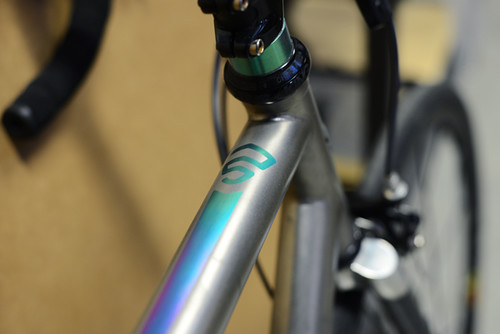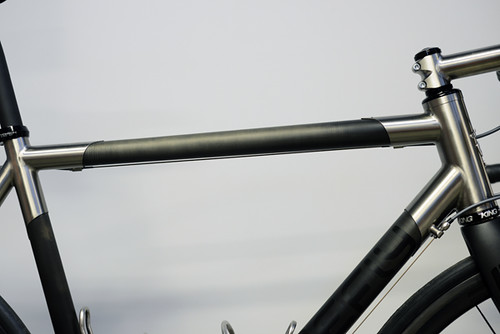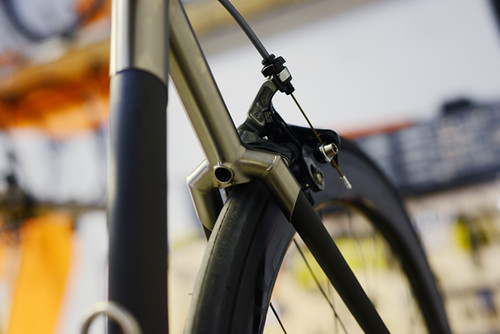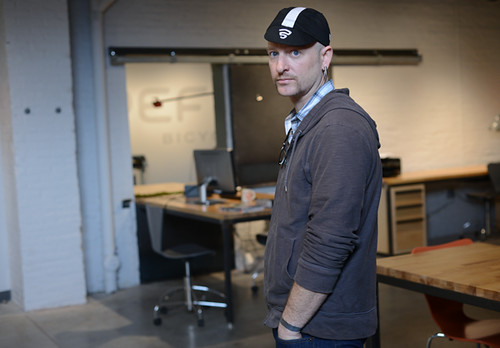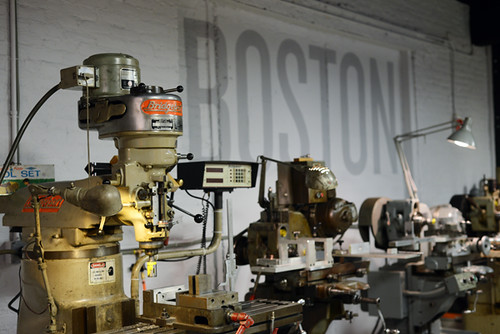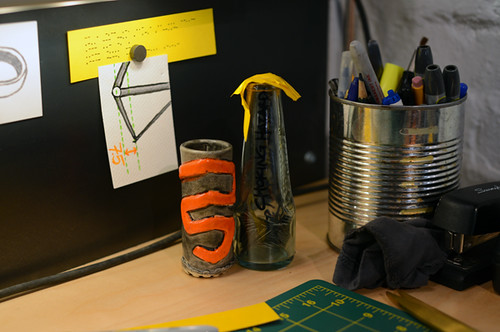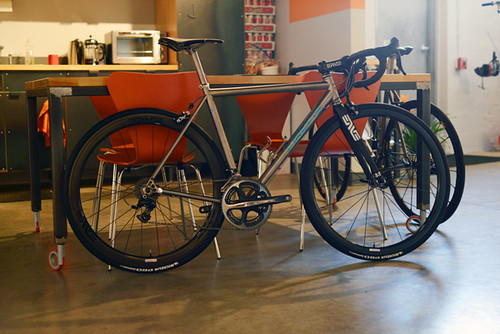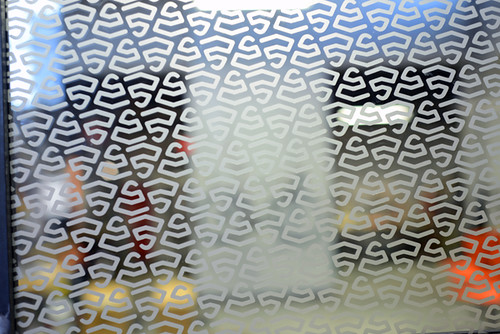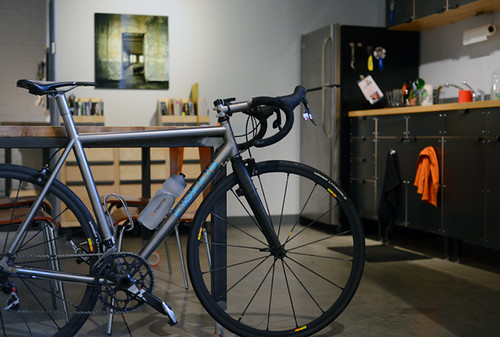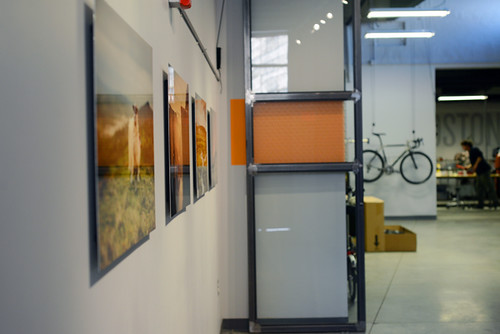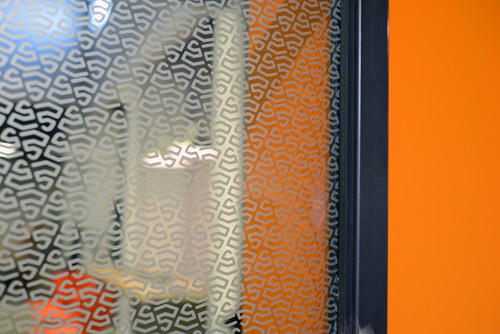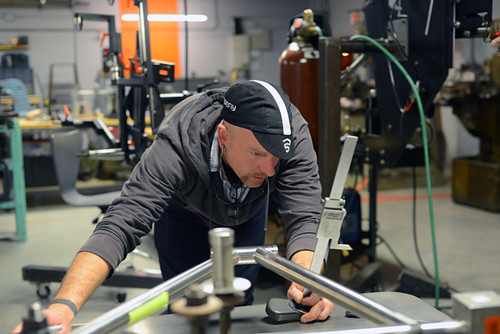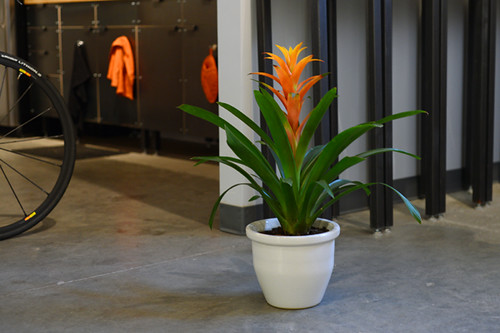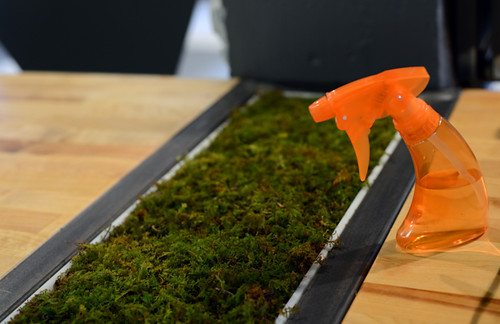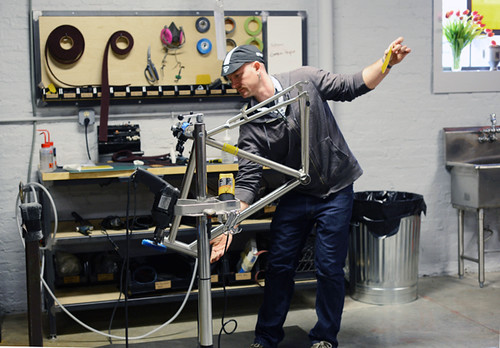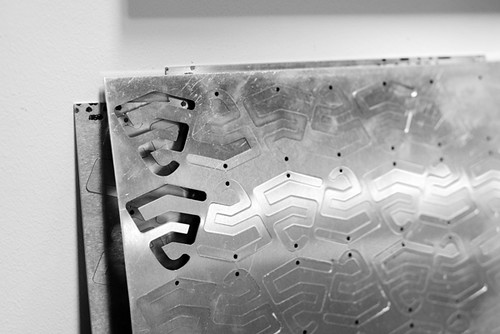It was quite foggy the whole way up to Exit 18. When we arrived at the cliffs, the path beneath the Near Trapps was muddy. The air seemed pregnant with moisture. But the rock appeared dry, or at least dryish. We walked in the direction of Gelsa (5.4), figuring it would be best to start with something easy. We dodged puddles on the trail.
Our plans changed when we stopped to look at Grand Central (5.9), a three-star classic. The vertical cracks at the start were very attractive to my crack-addicted partner Adrian. For my part, I was game for a three-star 5.9, but I wasn't sure I wanted to do it if the rock was damp. What happened to that easy warm-up we were going to do?
Adrian wasn't going to be denied. He was ready to go. So I said okay. But I didn't want to be on the hook for the crux second pitch, so I suggested he combine the short 5.6 pitch one and the steep 5.9 pitch two.

(Photo: Into the mist on Grand Central (5.9))
It turned out that the rock felt fine. Adrian flew up the first two pitches of Grand Central. He got to the traditional first belay in no time, then tiptoed through the rightward traverse around a nose to a stance beneath the steep, crux face on pitch two. Adrian complained about the traverse being a little spicy (his actual words were "that's a-one spicy meatball!") but I thought he had good pro. He then tried a couple different tactics before settling on his approach to the crux face. He started up right, then stepped down and went up left to the belay stance beneath the pitch three roof.
When I followed Adrian up I saw why Grand Central is such a great classic. There is a lot of variety on this climb. I enjoyed the crack climbing at the bottom, which is no giveaway, and the traverse around the nose, while not very difficult, is thin and quite exposed. I felt like I would have been fine leading the crux 5.9 face climbing that concludes pitch two, but the gear seems to come only at the very beginning of the crux moves, and the leader has to be comfortable working it out through the moves above this gear until the crux is basically over. It isn't particularly run out, but neither is it one of those one-move cruxes with gear over your head. There are several straightforward but steep moves in succession. I thought going to the right was definitely "the way" to do it. There are really good holds over there; every third one felt like a bomber jug to me.

(Photo: Getting started on pitch three of Grand Central)
By the time we all arrived at the belay I wasn't worried about the rock anymore; I was eager to lead pitch three. This pitch is short, but it is a doozy, through a big two-tiered overhang. Dick Williams says the pitch will go at 5.7 to 5.9 depending on your height. Immediately above the belay the huge roof looms. There is a notch running through the roof that provides a perfect slot for a #2 Camalot and a fist jam that isn't quite as good as you want it to be. The trick, if you're short like me and my partner Liz, is to find a way to get your feet up so you can reach for the jug above the roof. If you're a little taller, like Adrian, you can just stand there and grab the jug, making the climb a few grades easier and infuriating all of your partners in the process.
After a couple of false starts, stepping up, sliding/stepping/hopping down, then adding another back-up piece in case I fell out, I really went for it and it was a blast. I pulled up over the roof into a cramped, pumpy stance, wormed in another cam, moved awkwardly one step to the left, pulled over the second (easier) overhang, and it was over.
I couldn't recall a more exciting 20 feet of climbing. It was a great rush, and if you call it a 5.9 pitch, I would say it's a great introductory 5.9 lead. The hardest move is the very first one, and there's great gear. If you fail to grab the jug you can hop right down to the stance, as I did a couple of times.
In retrospect, I think it would be better to combine pitches two and three, rather than combining one and two as we did. This arrangement would better minimize drag. But I'm happy we combined one and two, because I got to lead pitch three!
After we were done with Grand Central we found Roseland (5.9), another three-star classic, sitting open. Dick Williams calls the first pitch one of the best 5.9s in the Gunks. I had never considered climbing Roseland before, but after taking one look at it I was eager to get on it. Roseland goes up a vertical crack at the back of a pretty open book. Halfway up the crack, there's a roof. And at at the end of the crack, a traverse under an overhang leads to the final moves up to a bolted anchor.

(Photo: approaching the first roof on Roseland)
It looked hard. And it was seeping a little water. But I also thought the pro looked great. The vertical crack seemed like it would provide secure placements at will. I figured the climbing would be a lot like the first pitch of Airy Aria, a corner climb in the Trapps that was one of my first 5.8 leads, and one that I really enjoyed.
I told Adrian I wanted this one. He was fine with it.
And then I proceeded to get my ass kicked a little bit.
I headed up the opening crack, placing lots of gear, having fun. The moves were great. Every step seemed technical, interesting. before I knew it I was at the roof. The crack continued around the side of the roof, providing good holds. I pulled up over the roof with no problems. Things were going well.
I was almost at the traverse. As I neared the top of the crack, the climb grew steeper, pumpier. I could see a pin out on the traverse, beneath the ceiling. It was a burly angle piton. I couldn't wait to clip it. But first I had to get established in the horizontal crack under the roof. This crack would provide the only handholds for the traverse. And the crack starts out very thin. With the pump clock ticking, I had no time to waste. I made a big step out, putting my right toe on a crease. I tried to stick my fingers in the crack. There was chalk all over it, so I thought I could use it. But I couldn't get my tips into it. The crack was too thin.
Suddenly I got scared, and a little spooked. I felt pumped, I was leaning out, and I had nothing to hold on to.
"Dude, watch me!" I yelled at Adrian. "I think I'm about to fall!"
I looked down and my last piece was, to my surprise, below my feet. I wanted gear higher, at the top of the vertical crack. I reversed the moves, going left and down a step. Then I got in a great cam and clipped it before saying "take" and hanging off of it.
I needed to regroup.
As I rested there a minute I looked over the traverse. I could now see the holds; I just hadn't reached far enough. And the feet followed an obvious line of edges. If I'd been more patient I might have seen all of this the first time. This was going to be okay.
Once I got going again, the first move of the traverse was the hardest. I made the big step and with great relief clipped the first pin. Moving to the second pin, the climbing was pumpy but I felt pretty secure with the hands and the feet. The traverse got easier as it progressed, and although I've read complaints that Roseland has gotten too polished, I can't say that problem ever entered my mind while I was climbing it.
After the traverse Roseland still comes at you: another couple of steep moves and a big mantle get you, finally, to the bolts.
As I look back on it, I think I did reasonably well with the actual climbing on Roseland, but the other aspects of my performance really suffered. I got scared and had to take. My rope management was horrible, creating so much drag that by the time I reached the anchor I could barely move the ropes. And I fumbled with a biner and dropped some nuts on the traverse. What can I say? This climb got to me a little bit. It was hard for me.
When I lowered off of it I felt exhausted.
But oh, what a great pitch. Roseland is packed with quality moves. It is a stiff 5.9 that just doesn't let up. I was sort of correct in figuring that it would be a like Airy Aria, except Roseland is longer, steeper, more technical, and includes a roof problem in the middle and a thin traverse at the end. Aside from all that, it is just like Airy Aria!
I would gladly lead Roseland again, and I hope to send it next time. Despite its difficulty I would recommend it to anyone looking for a 5.9 to try, because it takes such great gear. You can throw in a piece and take a break at any point if you want to. You would take a swing backwards if you blew the crux move to the pin, but so long as you place gear at the top of the vertical crack I don't think a fall there would be too bad.
After we'd all had our fill of Roseland I ran over to check on Birdland, a climb that has been on my ticklist for a long, long time. Something about the first pitch face just calls to me, begging me to climb it. It ascends the right-hand face of a big open book, much larger than Roseland's. The angle appears reasonable; the face seems so climbable. I have stood before it on several occasions and been so excited at the prospect of hopping on it. But I've held back, partly out of fear. Testpiece face climbs scare me, and Birdland is known as a testpiece face climb. It is a 5.8, but some people think it should be a 5.9.
The crowds have also kept me away. Birdland may be the most popular climb in the Nears. It always seems to be occupied. Both pitches are very highly regarded, and the first pitch ends at bolts that can be used to toprope several popular harder climbs around the corner as well.
Earlier in the day we weren't surprised to find Birdland occupied. But after we did Roseland, we found it open. And after my brave struggle with Roseland I realized I no longer feared Birdland. Gunks face climbs have felt really good to me lately. I felt good on Pas De Deux. I felt good on Apoplexy. Why not Birdland? It was time.
The only problem was that my buddy Adrian wanted to lead it. I had snatched Roseland from him, after all. It was his turn. And yet I had to have pitch one, and I told him so. I confessed I'd been working up to this lead for a long time. And bless his heart, he let me have it. Such a nice guy.
The pitch went down like butter.
It is a beautiful pitch. Great rock on a nice face. The line wanders just a bit but there is a natural path to it, pretty much straight up through flakes, then a touch right to the arete, then straight up again through the face to the anchor. After an initial steep cruxy move to get established on the face the angle is low, so there's no pump factor, just a bunch of great moves with very good pro.

(Photo: A mini-crux right off the deck on Birdland)
At one point there was an interesting move, right before a fixed piton, in which I stepped on a tiny pebble to move up. And afterwards I realized I had just done the crux everyone talks about. I recall reading about this crux; it is reputed to involve iffy pro and a "secret" crimper hold. But I had a good cam right before this move (I think it was a .3 or .4 Camalot in a vertical crack), and the so-called secret hold was so covered in chalk there was no way it could remain much of a mystery. For me, on this particular day, the crux was over before I even realized it was a challenge.
I'm not trying to pooh-pooh the crux of Birdland as if it's no big deal. Liz struggled with it when she followed the pitch, and she's a great climber. Last year I'm sure it would have been a whole different experience for me, too. And that's really my point: it is amazing how things can change when you lose a little weight and adjust your mindset. I'm now in a so much healthier place, both physically and mentally, than I was a year ago. Last year I wanted to believe I was still as solid as ever on Gunks 5.8s, but in the wake of my climbing accident I was really a different climber, worrying and shaking my way up climbs I would have cruised through before the accident. Now that I'm feeling good again I realize just how far I was set back.
It's so good to pick up where I left off, working on 5.9s and feeling awesome on the 5.8s. Reaching the bolts at the end of pitch one of Birdland was a little like a homecoming to me, even though I'd never been in that particular spot before. Everything about it seemed familiar and right. I can only pray to the climbing gods that the good karma continues; I know now how fragile progress can be. One stupid mistake or blown muscle and it could all get set back to zero. It happens all the time.
After the joy of pitch one I expected pitch two to be an afterthought. I had never given it much consideration before. But I knew it was supposed to be good, and very different from pitch one. From our vantage point at the bolts it sure looked steep. It was supposed to be Adrian's lead, but as we stood at the belay he told me that if I was into leading it he didn't mind giving it to me.
I was taken aback. I told him I'd be thrilled to lead it but that I didn't want to be a hog about it. He handed me the gear.
The second pitch of Birdland is not better than the first, but I think it is equally good. It starts with the technical crux, a few thin moves right above the anchor, to a pair of pitons that I'm guessing used to form the belay station for pitch one. After that, it is an overhanging jugfest up to a big, left-facing corner. There are ledges along the way if you want to take a rest. And then the physical crux comes: a steep and awkward pull up into the big corner.
Once you're in the corner, an easier traverse with good pro brings you to an escape from the roof and the finish. A very high quality pitch, with good pro the whole way. Steep and pumpy, it provides the perfect counterpoint for the technical face-climbing on pitch one. To my mind these two pitches together make Birdland perhaps the very best 5.8 in the Gunks.
No wonder it's so popular.







 As you can see, we have "Pickles." Pickles is a Cascade Fox. And unless you're an insensitive brute, most people would consider him a very adorable little guy. The problem is, Pickles was so charming, that he attracted a lot of friends, and with those friends came problems. This week, Pickles had to be euthanized (i.e. shot) because he was seriously injured. The general feeling is that he was injured because he was fed by humans.
As you can see, we have "Pickles." Pickles is a Cascade Fox. And unless you're an insensitive brute, most people would consider him a very adorable little guy. The problem is, Pickles was so charming, that he attracted a lot of friends, and with those friends came problems. This week, Pickles had to be euthanized (i.e. shot) because he was seriously injured. The general feeling is that he was injured because he was fed by humans. "After consultation with two wildlife veterinarians, we decided that this animal did not have reasonable prospects for survival in the wild. The leg injury was severe and there was some indication that there was head injury as well. This Cascade fox was fed by people well prior to the injury (even after the injury). Fed animals like this one quickly found that hanging around the
"After consultation with two wildlife veterinarians, we decided that this animal did not have reasonable prospects for survival in the wild. The leg injury was severe and there was some indication that there was head injury as well. This Cascade fox was fed by people well prior to the injury (even after the injury). Fed animals like this one quickly found that hanging around the  When I am not travelling abroad part-time, I am still travelling within the country (Netherlands including Belgium) full-time.
When I am not travelling abroad part-time, I am still travelling within the country (Netherlands including Belgium) full-time.






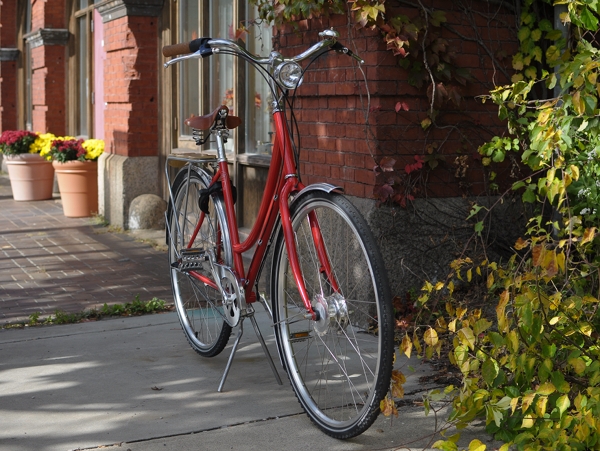 Last night we stopped by DBC City Bikes (formerly the Dutch Bicycle Company) in Somerville, MA to have a look at their new "Swift" line of bicycles. DBC - whose focus was previously on importing Dutch and Danish transport bikes - has now changed direction and established their own line of classichandbuiltbicycles. The Swift models are designed in house by Wentworth and MITgraduates and built to spec by local framebuilders. They had a few floor models at the shop, and I test rode the loop frame ladies' version.
Last night we stopped by DBC City Bikes (formerly the Dutch Bicycle Company) in Somerville, MA to have a look at their new "Swift" line of bicycles. DBC - whose focus was previously on importing Dutch and Danish transport bikes - has now changed direction and established their own line of classichandbuiltbicycles. The Swift models are designed in house by Wentworth and MITgraduates and built to spec by local framebuilders. They had a few floor models at the shop, and I test rode the loop frame ladies' version. The Swift is TIG-welded cro-moly steel.The build includes upright handlebars, Brooks saddle, internally geared hub, front and rear drum brakes, dynamo lighting, fenders, chainguard, rear rack, and a cafe lock.The curvature of the top tube is executed nicely, and the welding is very clean. There are no dress guards, but nowadays it is becoming easier to purchase those separately. The lack of a full chaincase could be problematic for those who want one, but others would consider the chainguard sufficient. Everything else you might need in a transport bike is included.
The Swift is TIG-welded cro-moly steel.The build includes upright handlebars, Brooks saddle, internally geared hub, front and rear drum brakes, dynamo lighting, fenders, chainguard, rear rack, and a cafe lock.The curvature of the top tube is executed nicely, and the welding is very clean. There are no dress guards, but nowadays it is becoming easier to purchase those separately. The lack of a full chaincase could be problematic for those who want one, but others would consider the chainguard sufficient. Everything else you might need in a transport bike is included. As always, I am not a fan of unicrown forks, but at least the welding here is nice and neat. The fork blades are curved. There are cable routing guides for the lights and brakes. Not sure how they are attached - they do not seem to be braze-ons - and why they were made in a contrasting colour.
As always, I am not a fan of unicrown forks, but at least the welding here is nice and neat. The fork blades are curved. There are cable routing guides for the lights and brakes. Not sure how they are attached - they do not seem to be braze-ons - and why they were made in a contrasting colour. The dynamo headlight and tail light are custom: DBC fitted what I think might be SunLite casings with LEDs and turned them into dynamo driven lights with a standlight feature. It's a neat system and the lights are very bright.
The dynamo headlight and tail light are custom: DBC fitted what I think might be SunLite casings with LEDs and turned them into dynamo driven lights with a standlight feature. It's a neat system and the lights are very bright. Tail light. Front and rear hubs are Sturmey Archer. The bicycle I test rode was a 3-speed, but they are also available as single speeds and 5-speeds.
Tail light. Front and rear hubs are Sturmey Archer. The bicycle I test rode was a 3-speed, but they are also available as single speeds and 5-speeds. The fluted fenders look like VO to me. The wheels are 700C.
The fluted fenders look like VO to me. The wheels are 700C.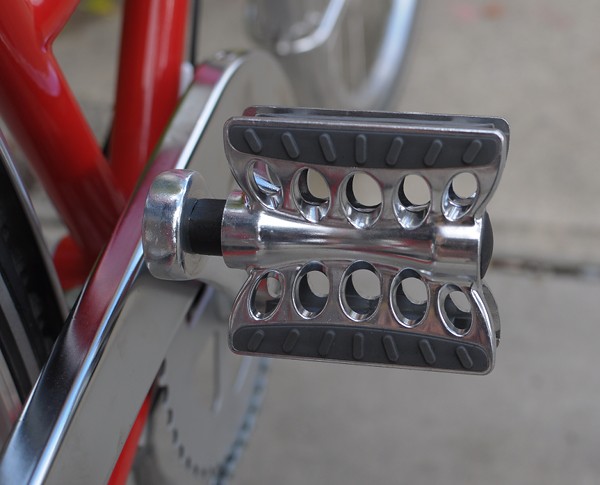 The pedals are attractive and grippy, but it is a trade secret where they are sourced from! (Anybody happen to know?...)
The pedals are attractive and grippy, but it is a trade secret where they are sourced from! (Anybody happen to know?...)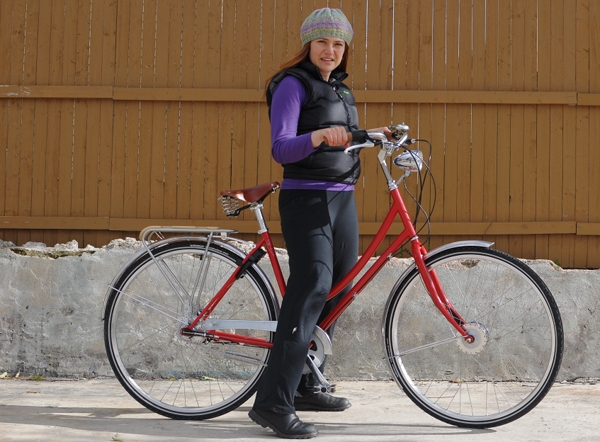 Riding the DBC Swift was a very particular experience. In many ways, it handles like a classic Dutch bike (think Gazelle or Batavus, as opposed to Pashley or Velorbis), but is lighter and more responsive. The angles are steeper and other aspects of the geometry are a bit different, but still - all in all the Dutch bike qualities seem to dominate. In the picture above, you can see how tall the headtube is and how high up the handlebars are - almost at my chest. The resultant sitting position is bolt upright.
Riding the DBC Swift was a very particular experience. In many ways, it handles like a classic Dutch bike (think Gazelle or Batavus, as opposed to Pashley or Velorbis), but is lighter and more responsive. The angles are steeper and other aspects of the geometry are a bit different, but still - all in all the Dutch bike qualities seem to dominate. In the picture above, you can see how tall the headtube is and how high up the handlebars are - almost at my chest. The resultant sitting position is bolt upright. I was not sure what to expect, but I have to say the ride quality was nice: smooth, peppy, lightish, and with an easy feel to it. The bike is stable and easy to control. When my hat flew off my head, I caught it while continuing to cycle; the bike seems fairly klutz-proof. Another notable aspect of the bike, was the superior functionality of the drum brakes. All other drum-brake city bikes I have tried or owned were fitted with 70mm version, whereas DBC fitted the Swift bikes with the 90mm version. Especially for the front brake, the difference in braking power is substantial.
I was not sure what to expect, but I have to say the ride quality was nice: smooth, peppy, lightish, and with an easy feel to it. The bike is stable and easy to control. When my hat flew off my head, I caught it while continuing to cycle; the bike seems fairly klutz-proof. Another notable aspect of the bike, was the superior functionality of the drum brakes. All other drum-brake city bikes I have tried or owned were fitted with 70mm version, whereas DBC fitted the Swift bikes with the 90mm version. Especially for the front brake, the difference in braking power is substantial.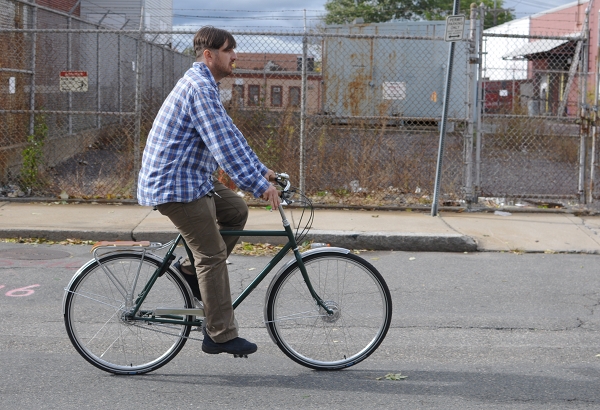 As I was riding the ladies' Swift, the Co-Habitant took a spin on the men's version. I should note that the men's and ladies' versions of the Swift are completely different bikes, designed by separate teams. The angles are different, the proportions, everything. So while my experience of the ladies' model was positive, I have no idea how the mens' handles, and the Co-Habitant's feedback was vague. When it comes to city bikes, I think he is a creature of habit and prefers his Pashleyover pretty much anything else.
As I was riding the ladies' Swift, the Co-Habitant took a spin on the men's version. I should note that the men's and ladies' versions of the Swift are completely different bikes, designed by separate teams. The angles are different, the proportions, everything. So while my experience of the ladies' model was positive, I have no idea how the mens' handles, and the Co-Habitant's feedback was vague. When it comes to city bikes, I think he is a creature of habit and prefers his Pashleyover pretty much anything else. With the ladies' Swift, my impression is thatDBCaccomplished what they set out to accomplish in terms of performance. The price of a fully built bicycle is in the $2,000's, depending on the options. Each bike is built to order and custom paint colour is included in the price. How will the DBC Swiftdo in the long run of course remains to be seen. But it is good to have options: When it comes to handbuilt TIG-welded ladies' bicycles,DBC joins the likes ofANT and Geekhouse.The work of all three builders is different. If you are in the area, try them out for yourself!
With the ladies' Swift, my impression is thatDBCaccomplished what they set out to accomplish in terms of performance. The price of a fully built bicycle is in the $2,000's, depending on the options. Each bike is built to order and custom paint colour is included in the price. How will the DBC Swiftdo in the long run of course remains to be seen. But it is good to have options: When it comes to handbuilt TIG-welded ladies' bicycles,DBC joins the likes ofANT and Geekhouse.The work of all three builders is different. If you are in the area, try them out for yourself!

 About a week ago, I left the house in the morning to discover the wall of a nearby building covered in graffiti. Screaming for attention with its searing yellow hue and the swirly sunshine dotting the "i" the graffiti tells the residents of our little neighbourhood to "smile." Very funny, we think. Smile because they defaced property? Smile because someone will have to spend time cleaning that up in mid-summer heat and humidity? Smile because this action rubs it in our faces that we are powerless to prevent others violating our living space?
About a week ago, I left the house in the morning to discover the wall of a nearby building covered in graffiti. Screaming for attention with its searing yellow hue and the swirly sunshine dotting the "i" the graffiti tells the residents of our little neighbourhood to "smile." Very funny, we think. Smile because they defaced property? Smile because someone will have to spend time cleaning that up in mid-summer heat and humidity? Smile because this action rubs it in our faces that we are powerless to prevent others violating our living space? I am not comparing cycling to graffiti, really I am not. But it is impossible not to notice that those who don't ride bikes often feel threatened and, yes, even invaded by the appearance of bicyclists and (gasp) bike lanes in their neighbourhoods. These are strong feelings that those of us who cycle cantoo easily dismiss. But look at it this way: If after some time a vandalised wall can make us smile because of its sunny message, then surely the fun of cycling can be contagious enough to override any hostility toward it as well.
I am not comparing cycling to graffiti, really I am not. But it is impossible not to notice that those who don't ride bikes often feel threatened and, yes, even invaded by the appearance of bicyclists and (gasp) bike lanes in their neighbourhoods. These are strong feelings that those of us who cycle cantoo easily dismiss. But look at it this way: If after some time a vandalised wall can make us smile because of its sunny message, then surely the fun of cycling can be contagious enough to override any hostility toward it as well.











